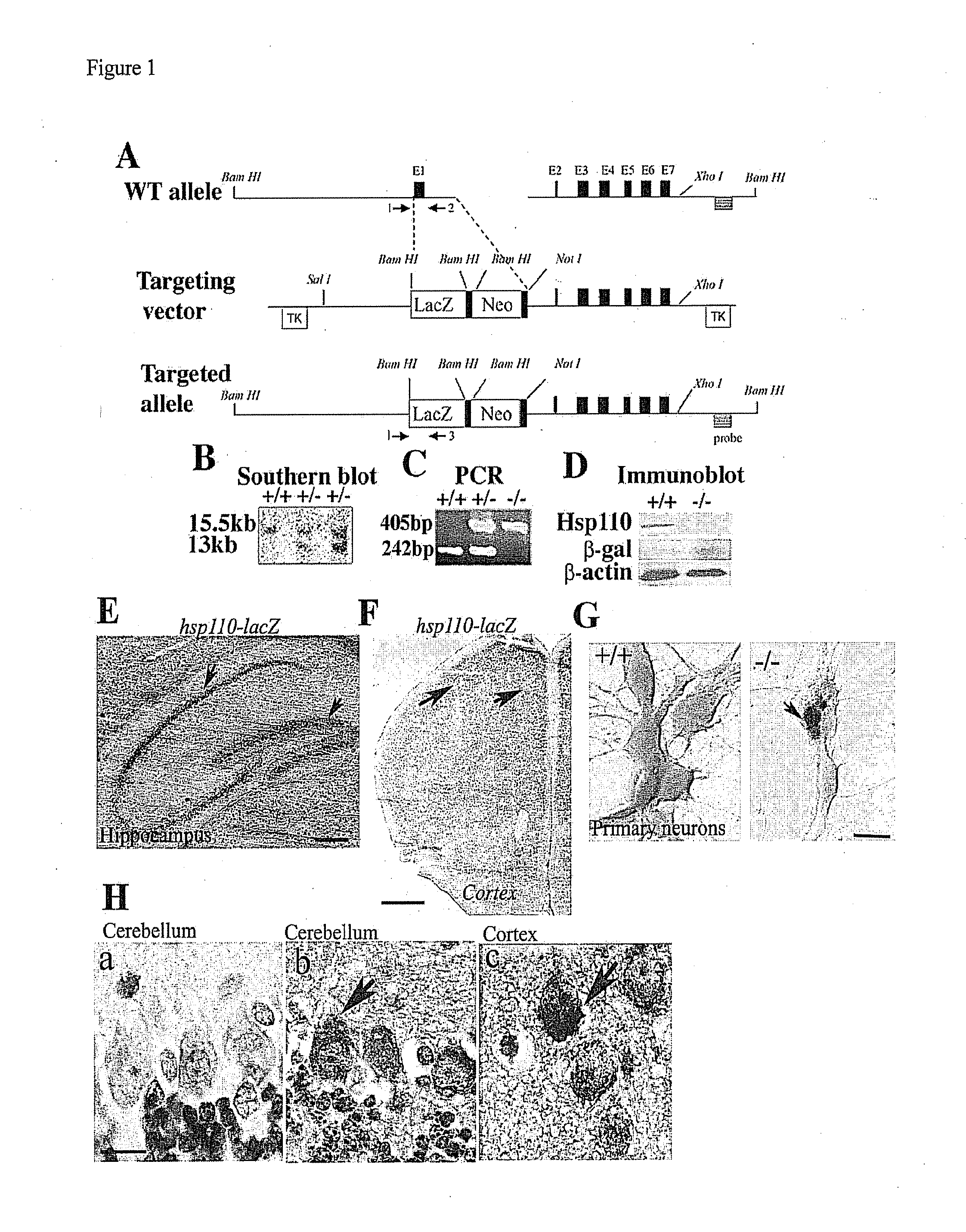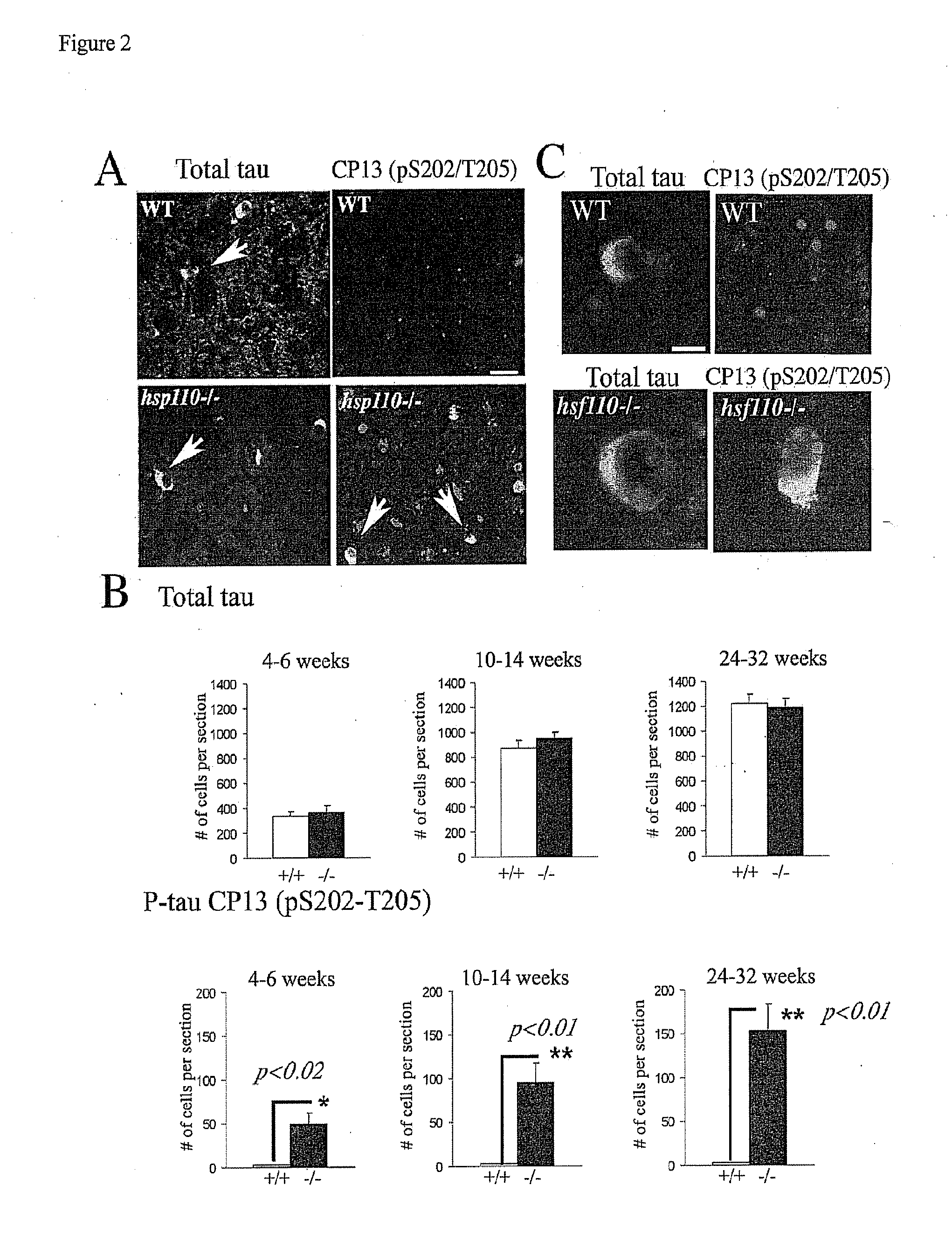Heat shock protein deficiencies as model systems for brain pathology and cancer
a brain pathology and cancer technology, applied in the field of heat shock protein deficiencies as model systems for brain pathology and cancer, can solve the problems of not offering a permanent cure for the disease, cancer is a widespread and deadly disease, and the economic and social burden of neurodegenerative diseases is huge and growing rapidly. to achieve the effect of reducing the expression and/or function of hsp70
- Summary
- Abstract
- Description
- Claims
- Application Information
AI Technical Summary
Benefits of technology
Problems solved by technology
Method used
Image
Examples
example 1
[0146]Loss of Heat Shock Protein (Hsp) 110 Leads to Tau Hyperphosphorylation and Early Accumulation of Insoluble Amyloid-β Peptide in Mouse Model of Alzheimer's Disease
[0147]Accumulation of tau into neurofibrillary tangles is a pathological consequence of Alzheimer's disease, Parkinson's disease, and other tauopathies. Failures of the quality control mechanisms by the heat shock proteins (Hsps) have been positively correlated with the appearance of such neurodegenerative diseases. However, in vivo genetic evidence for the role of Hsps in neurodegeneration remains elusive. Hsp110 is a nucleotide exchange factor for the Hsp70 family and has been named a “holdase” because direct substrate binding to Hsp110 may facilitate substrate folding. To provide genetic evidence for a potential role for Hsp110 in neurodegeneration, we have generated hsp110− / − mice. Our results show that absence of the Hsp110 gene in mice leads to an age-dependent accumulation of hyperphosphorylated tau. Towards de...
example 2
Generation and Analysis of Hsp70.1 and Hsp70.3 (Hsp70i) Deficient Mice
[0196]High levels of Hsp90, Hsp70 and Hsp27 expression either individually or in combination have been widely reported in human tumors, especially those of epithelial origin. Indeed this has been suggested to be of prognostic value in cancer in that over-expression of Hsps correlated with poor patient outcome in certain tumors (Jaattela, 1995 Int J Cancer 60:689-693; Vargas-Roig et al., 1997 Cancer Detect Prey. 21:441-451; Nanbu et al., 1998 Cancer Detect Prey 549-555; Mosser and Morimoto, 2004 Oncogene 23:2907-2918; Jaattela, 2004 Oncogene 23:2746-2756; Ciocca and Calderwood, 2005 Cell Stress and Chaperones 10:86-103). Therefore, based on the prediction that high levels of molecular chaperones are protective against cell death and increase cell survival against toxic insults such as chemotherapy agents, targeting Hsp expression or function has been suggested as an effective anti-cancer strategy for many tumor typ...
example 3
Wild-Type Mice Exhibit Sensitivity to Traumatic Brain Injury (TBI)-Induced Edema
[0213]We have subjected wild-type to TBI and performed MRI analyses after 24 hours, 1 or 3 weeks. FIG. 21 shows imaging brain edema following TBI in mice. TBI was applied using a 2 mm diameter pneumatic piston (Air-Power, Inc. High Point, N.C.) (Griebenow et al., 2007 J Neurotrauma 24:1529-1535; Zweckberger et al., 2006 J Neurotrauma 23:1083-1093). The impactor is discharged at 6.8+ / −0.2 m / s with the head displacement of 3 mm. The MRI shows significant areas of edema following TBI (FIG. 21A). We also subjected both wild-type and hsp110− / − mice to TBI. In FIG. 21B, wild-type male mice (n=5) were subjected to TBI and 24 hours later, brain water content was estimated in a 3 mm coronal tissue section of the ipsilateral cortex (or corresponding contralateral cortex that were not treated), centered on the impact site. Tissues were immediately weighed (wet weight), then dehydrated at 65° C.) (Miao et al., 2001 ...
PUM
| Property | Measurement | Unit |
|---|---|---|
| molecular weights | aaaaa | aaaaa |
| pH | aaaaa | aaaaa |
| pH | aaaaa | aaaaa |
Abstract
Description
Claims
Application Information
 Login to View More
Login to View More - R&D
- Intellectual Property
- Life Sciences
- Materials
- Tech Scout
- Unparalleled Data Quality
- Higher Quality Content
- 60% Fewer Hallucinations
Browse by: Latest US Patents, China's latest patents, Technical Efficacy Thesaurus, Application Domain, Technology Topic, Popular Technical Reports.
© 2025 PatSnap. All rights reserved.Legal|Privacy policy|Modern Slavery Act Transparency Statement|Sitemap|About US| Contact US: help@patsnap.com



